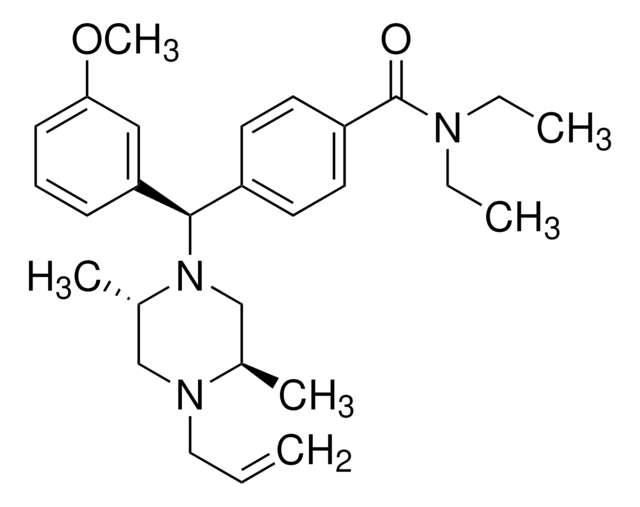G0544
GR 103691
≥98% (HPLC), solid
Sinónimos:
4′-Acetyl-N-[4-[4-(2-methoxyphenyl)-1-piperazinyl]butyl]-[1,1′-biphenyl]-4-carboxamide
Seleccione un Tamaño
US$ 261,00
Fecha estimada de envío23 de mayo de 2025
Seleccione un Tamaño
About This Item
US$ 261,00
Fecha estimada de envío23 de mayo de 2025
Productos recomendados
Ensayo
≥98% (HPLC)
Formulario
solid
color
white
solubilidad
DMSO: soluble >5 mg/mL at 60 °C
emisor
GlaxoSmithKline
temp. de almacenamiento
2-8°C
cadena SMILES
COc1ccccc1N2CCN(CCCCNC(=O)c3ccc(cc3)-c4ccc(cc4)C(C)=O)CC2
InChI
1S/C30H35N3O3/c1-23(34)24-9-11-25(12-10-24)26-13-15-27(16-14-26)30(35)31-17-5-6-18-32-19-21-33(22-20-32)28-7-3-4-8-29(28)36-2/h3-4,7-16H,5-6,17-22H2,1-2H3,(H,31,35)
Clave InChI
JARNORYOPMINDY-UHFFFAOYSA-N
Información sobre el gen
rat ... Htr1a(24473)
Aplicación
Acciones bioquímicas o fisiológicas
Características y beneficios
Información legal
Código de clase de almacenamiento
11 - Combustible Solids
Clase de riesgo para el agua (WGK)
WGK 3
Punto de inflamabilidad (°F)
Not applicable
Punto de inflamabilidad (°C)
Not applicable
Equipo de protección personal
Eyeshields, Gloves, type N95 (US)
Elija entre una de las versiones más recientes:
Certificados de análisis (COA)
¿No ve la versión correcta?
Si necesita una versión concreta, puede buscar un certificado específico por el número de lote.
¿Ya tiene este producto?
Encuentre la documentación para los productos que ha comprado recientemente en la Biblioteca de documentos.
Active Filters
Nuestro equipo de científicos tiene experiencia en todas las áreas de investigación: Ciencias de la vida, Ciencia de los materiales, Síntesis química, Cromatografía, Analítica y muchas otras.
Póngase en contacto con el Servicio técnico








